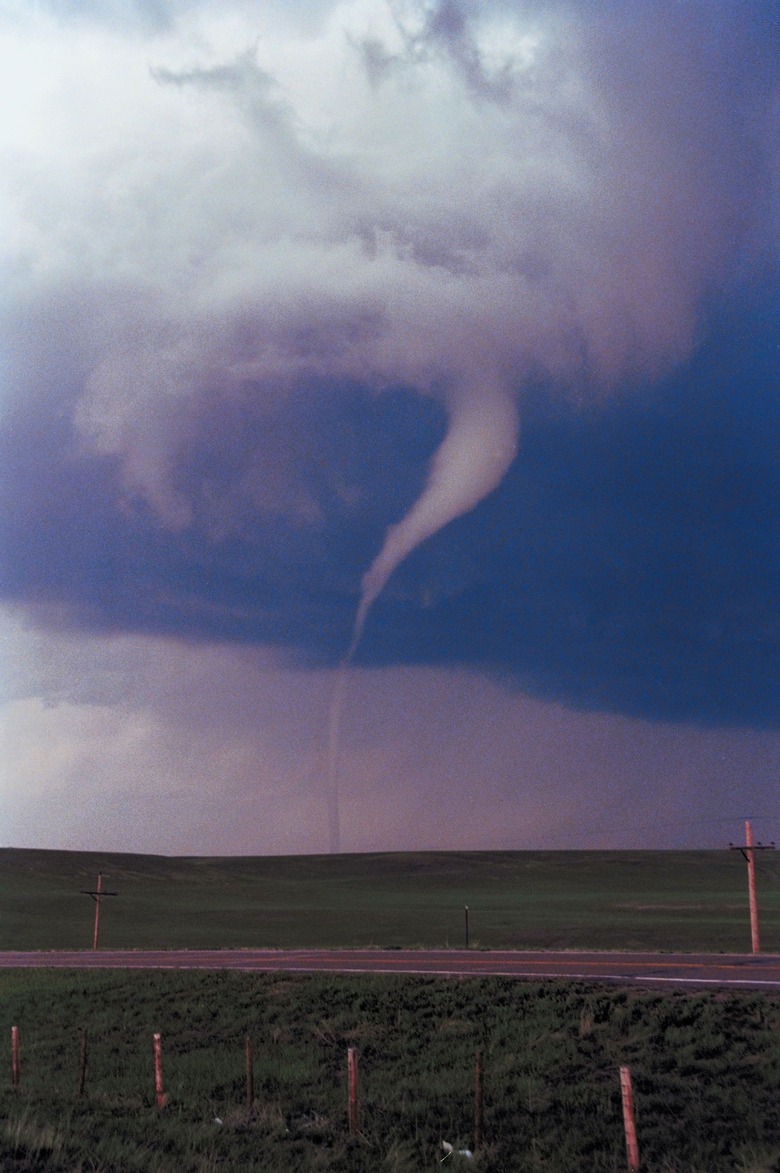The Difference Between Straight Line Winds & Tornadoes
Severe weather systems are capable of producing extremely powerful winds capable of blowing down trees and damaging structures. While the primary focus of storm spotters is usually on tornadoes, straight-line wind formations such as downbursts and derechos can be almost as devastating. The three types of storms can produce similar effects, although there are many differences among the weather formations.
Origins
Origins
A tornado forms when uneven temperatures across a frontal boundary cause wind shear, strong winds moving in different directions. If conditions are right, the wind movement will become circular, drawing energy into the vortex and forming a tornado. Downbursts occur when a column of rain-cooled air sinks rapidly, striking the ground and fanning out in all directions as a strong burst of winds. Derechos happen when air convection before a storm energizes the falling air inside the system, creating a line of fast-moving downbursts that travel quickly across a region.
Wind Speed
Wind Speed
Tornado strength follows the Enhanced Fujita Scale, with a low-end tornado bearing winds of at least 105 kilometers per hour (65 mph). The most powerful tornado to be successfully recorded struck Oklahoma City on May 3, 1999, with wind speeds measured at 512 kilometers per hour (318 mph). According to the National Weather Service, the strongest downburst on record occurred in August 1983 in Washington, D.C., with speeds of over 210 kilometers per hour (130 mph). Derechos can produce high winds as they move, sometimes sustained winds over 160 kilometers per hour (100 mph) over a very large front.
Area of Effect
Area of Effect
Downbursts created by a storm can vary significantly in size, ranging from microbursts a few hundred meters across to larger events covering up to 10 kilometers (6.2 miles). Tornadoes range from a few hundred meters (650 feet) to 2 kilometers (1.2 miles) across, in the case of large wedge tornadoes, and can cause devastation for miles as they travel along the ground. Derechos, on the other hand, are enormous systems that can form squall lines hundreds of kilometers long as they blast through a region.
Lifespan
Lifespan
Downbursts are extremely short-lived weather phenomena that can form and dissipate within moments, making them extremely dangerous due to their unpredictability. In August 1985, a microburst struck an airport in Dallas, causing the crash of Delta Flight 191 and leading to increased study of these transitory wind events. Tornadoes usually remain coherent for a matter of minutes, although particularly powerful storms can dissipate and reform multiple times as a storm system passes, causing long trails of damage. Derechos can last 24 hours or more under the right circumstances, such as the July 10-11, 2011, derecho that swept from Colorado all the way to Virginia before dissipating.
Cite This Article
MLA
Kazmeyer, Milton. "The Difference Between Straight Line Winds & Tornadoes" sciencing.com, https://www.sciencing.com/difference-between-straight-line-winds-tornadoes-4673/. 24 April 2017.
APA
Kazmeyer, Milton. (2017, April 24). The Difference Between Straight Line Winds & Tornadoes. sciencing.com. Retrieved from https://www.sciencing.com/difference-between-straight-line-winds-tornadoes-4673/
Chicago
Kazmeyer, Milton. The Difference Between Straight Line Winds & Tornadoes last modified March 24, 2022. https://www.sciencing.com/difference-between-straight-line-winds-tornadoes-4673/
